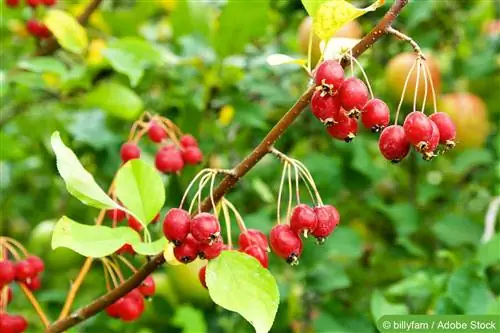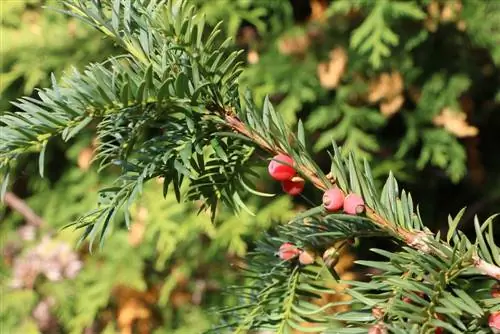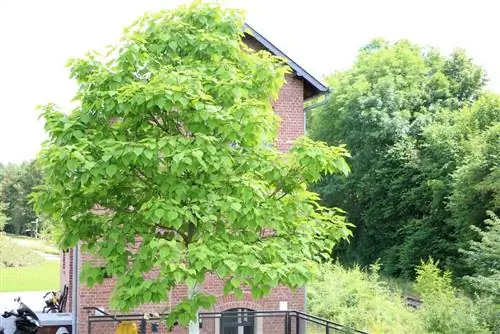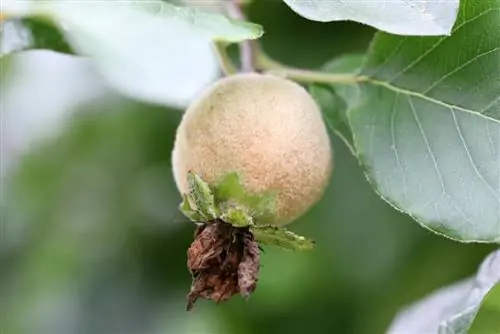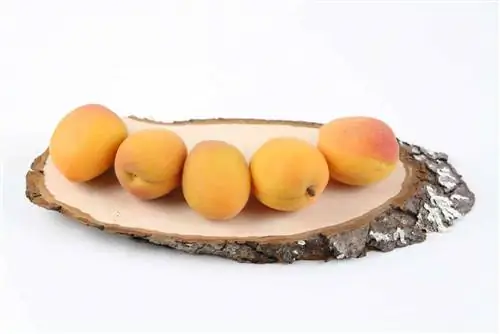- Author admin [email protected].
- Public 2023-12-17 03:39.
- Last modified 2025-06-01 06:48.
The crabapple is wonderfully suitable as a decoration for the garden. It impresses with its beautiful fruits, which are edible but not necessarily tasty. There are around 30 wild forms in Europe that have been enriching gardens for centuries.
Varieties
The best-known varieties include:
- ‘John Downie’ - orange-red apples
- ‘Golden Hornet’ - yellow apples
- ‘Evereste’
- ‘Butterball’
- ‘Makamik’
Depending on how tall the tree can grow, different varieties can be selected. All of them offer a high decorative value for the garden due to their flower color and the color of the crabapples. The apples can also be used for decoration purposes or for crafts. They develop in autumn and remain on the tree until January. Crabapple trees bear abundant fruit, even when the trees themselves are young or small.
The different types of crabapples
Since crabapple trees have been cultivated for a very long time, there are now a variety of different varieties. They carry apples that not only have different colors, but also hang on the branch in different sizes. Some of them only grow to 1-2 cm and can also be considered cherries. Others are 3-4 cm in size. Since the leaves and flowers are also colored differently, the crabapple is always an asset to any garden, regardless of its shape. The trees can be just as different as the apples themselves. That's why it is preferred for small gardens to achieve beautiful decorative decoration. Some are only around two meters high, others can be six or more meters high.
Tip:
Crabapples can be cooked into jam.
Location for crabapple trees
A crabapple tree can often be seen in small and large gardens as well as in public parks or large green spaces. It prefers a sunny location, which can also extend into partially shaded areas. He has no special demands on the soil; normal garden soil is completely sufficient for him. It should be moist and can be loamy, sandy, chalky or humus. If the crabapple tree is to be placed in a pot on the terrace, it needs enough space and then regular water and fertilizer. If the supply of water and nutrients is not regular, it may stop producing fruit. In the bucket it can be left on the terrace in winter. Protection made of fleece or foil in severe frost can be good for him.
Planting tips for crabapples
The planting hole should be large enough even for a relatively small crabapple bush or tree. Depending on how extensive the roots are, it should be between 40-60 cm deep and up to 80 cm in diameter. This gives the new roots an opportunity to connect to the earth more quickly. Grafted crabapples are placed back into the soil a hand's breadth above the soil surface. Good compost, stone or algae powder can be added to the planting hole to make it easier for the tree to grow, but under no circumstances should horse manure or other stable manure be mixed in.
Cutting crabapple trees
Even though this tree is quite small and, unlike its big brother, the apple tree, doesn't take up much space, there are situations in which you want to cut it back. This is possible without any problems; there are even different times of the year when the crabapple tree can be cut. In this way, his external appearance can be corrected and influenced so that he then presents his beautiful image in the garden.
Cut in summer
- The crabapple tree can be branched, as the specialist calls it. This practically means an increase in the crown.
- For this purpose, the lower branches of the crown are removed using either pruning shears or a pruning saw.
- Even with this tree cut, no long part of the branch should be left standing.
- These “coat hooks” are unfavorable to the he althy growth of the tree.
- First, the branch that is to be removed is sawn from below and then sawn through from above.
- The stump can then be shortened further.
- However, the so-called branch collar should not be destroyed in the process - this refers to the direct attachment of the branch to the tree trunk, i.e. the thick base.
Cut in autumn and winter
- In order to thin out the crown regularly, cutting in autumn or winter is possible.
- Then the dead wood in the crown can be removed.
- Use this opportunity to remove a few thick branches of the crown.
- Care should be taken to cut back evenly.
- Similarly, you should first saw from below and then saw through from above to avoid tearing.
Potential pests of crabapples
A crabapple tree can be affected by scab or mildew, which can occur quickly, especially on dry soil. The diseases can be treated with chemical agents, but since this is not very promising, you should consider replanting a different variety. The leaves from diseased trees should not be put in the compost, but rather in the household waste. Most often, an illness is diagnosed through a general nutrient deficiency. If the crabapple is fundamentally weakened, such diseases appear more quickly than usual. They can also transmit neighboring plants.
What you should know about the crabapple in brief
There are different varieties of the crabapple tree, and the popular plant impresses with either red, yellow or orange apples. The crabapple tree is called the cherry apple, among other things, because of its cherry-sized fruits and was known in ancient times as the “crab apple”.
History of the crabapple: From crabapple to sought-after object
- The crabapple tree originally comes from the Black Sea region and looks back on over 5,000 years of history.
- Its “roots” can be found as early as the Neolithic period. Even back then, delicious applesauce and similar dishes were prepared from ornamental apples.
- It was later discovered that the pectin contained in large quantities in the fruits is suitable as a gelling agent.
- The dried fruit is also used in many different ways, especially as a decoration.
As diverse as the possible applications are, caring for the crabapple tree is still simple and uncomplicated. The plant is extremely adaptable and even thrives in soils that are less rich in nutrients. In principle, however, the soil quality should be improved through regular fertilization and loosening.
- It is worth knowing that the crabapple tree is also frost-resistant to a certain extent.
- Nevertheless, it makes sense not to expose the tree to harsh climatic conditions.
- Windy locations, for example, are out of the question in this regard.
Crabapple tree in a pot
Apple trees are very popular, but they also take up a lot of space in a garden. If the garden is not big enough for an apple tree or there is no garden at all, you don't necessarily have to do without an apple tree, because there is the crabapple tree, which you can also grow in a container. And a bucket finds its place on the terrace as well as on a small balcony.
The crabapple tree can be planted all year round. When buying a potted plant, you should make sure that the pot contains neither just roots and a little soil, nor a lot of soil with few roots. The first variant has been in the pot for far too long, the other too short. Both cannot grow well and have little resistance to weather conditions and pests.
Crabapple trees basically only need a little space and grow to a maximum height of two meters. The selection of varieties is very large, so you should take the future location conditions into account.
Most crabapple tree varieties can easily tolerate full sun, but also thrive in shady locations. The typical flowering time for a crabapple tree, regardless of the variety, is in May and June. During this time, the crabapple tree impresses with its lush blossoms, which quickly makes it a highlight on every terrace and balcony. The fruits are very aromatic and can be harvested from October to November.
Care and pruning of the crabapple tree
Crabapple trees need just as much care as any other apple tree. In any case, this includes regular pruning, making sure that the correct branches are cut and the correct shape is cut. There are now even courses on this topic in which you can learn exactly how to cut fruit trees. Tree nurseries and some garden centers offer such courses.
In terms of soil, it should be nutrient-rich and moist soil. The crabapple tree reacts very sensitively to a lack of water and nutrients.
You can tell that there is a nutrient deficiency when the leaves turn brownish and eventually fall off. In such a case, you can help a little with an appropriate fertilizer.

